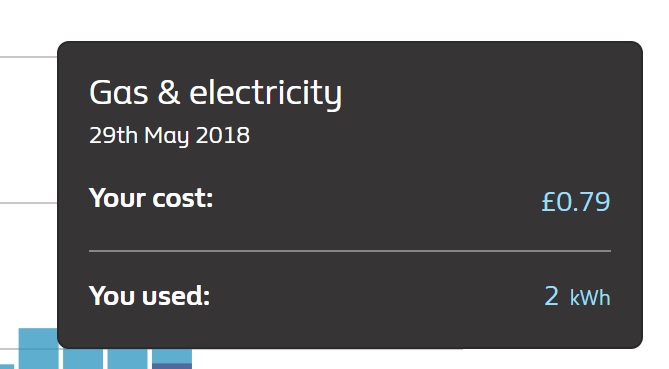I recently had my electricity and gas meters upgraded to “smart” meters. They aren’t that smart. All they do is upload my meter reading to the utility company at regular intervals along with this information being displayed on a screen. I look at the screen now and then but I do think that eventually I will turn it off. I know roughly how much I spend each day and it’s not really a surprise.

This graph shows the energy use each day with the lower darker bar being electricity and the light blue being gas. I have a gas boiler for water and heating along with a gas hob. The oven is electric. This can be translated into costs [at current market rates]:

At the end of May I went away for a while and I normally try to shut-down most of the energy using devices in the house. The physical process can take about 5 minutes walking around the house making sure that everything is shut down in the correct order.
If you look at the last week of May you can see low and consistent energy costs. Although no gas was used in this time period the monetary costs is the standing charge that I pay for the privilege of having a gas supply.

My daily energy use in a house that is mostly turned off is 2kWh. This accounts for the following items:
- Fridge
- Microwave clock
- Oven clock
- Modem / Router
- ADS-B aircraft tracker in the loft
- Alarm clock
- That extension lead orange light
It is taking a while for my head to get around this bizarre and stupid unit the kWh. But here goes:
My house’s power usage at baseline is 83 Watts. A human during the normal day runs at about 100 Watts [as does a 100W incandescent light bulb]. Over the course of the day this ends up being 7.2 MJ. My house needs to consume about the same amount of food as a human to run at its lowest power consumption levels.
Wolfram Alpha has some lovely comparisons for energy usage, so 2 kWh is the same as:
- ≈ 1.7 × energy released by explosion of one kilogram of TNT ( 1 kilogram of TNT )
- ≈ 0.57 × average electrical energy required by an Apple iPhone 5 per year (≈ 1.3×10^7 J )
And my favourite is:
- Relativistic mass m from E = mc^2: 80 ng (nanograms)
When I next go away it would be interesting to see how low I could get the consumption. To be fair, I could just turn the electricity off at the mains. But the only thing I could still power down is the ADS-B receiver and I like to keep that going because I can log into it from around the world.
